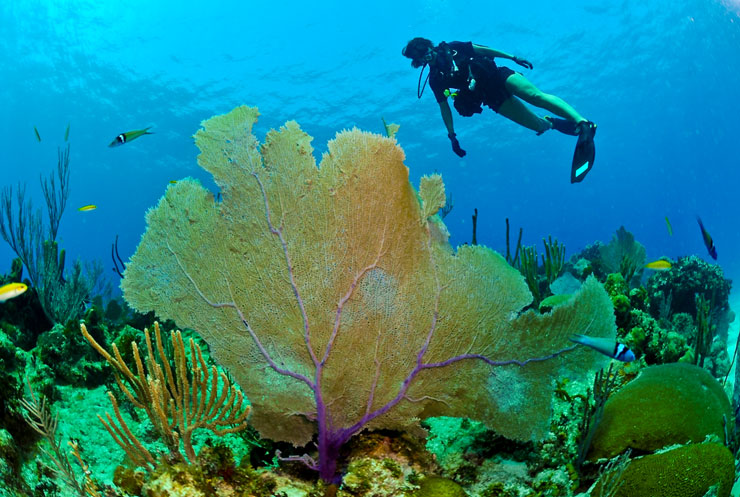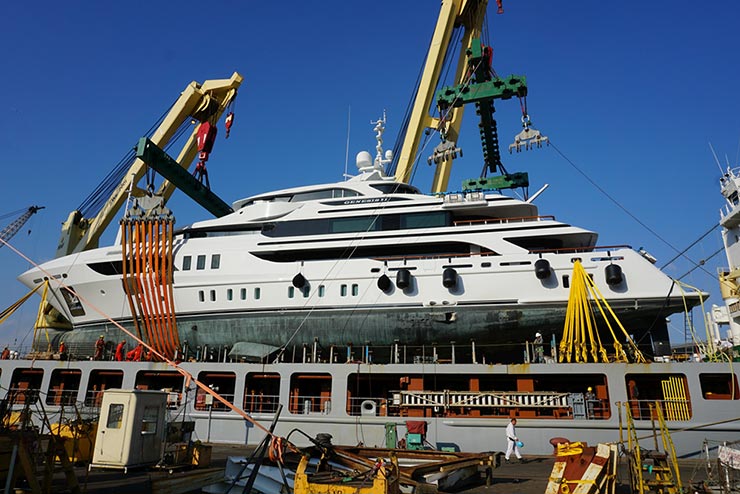
Playa Pilar, a beach on the west end of Cayo Guillermo on Cuba’s north side, is named after Ernest Hemingway’s boat and is alleged to be one of the settings in the author’s Islands in the Stream.
Powerboats: Cuba is closer than you think
The distance from Miami to Nassau, Bahamas, is 186 miles—close enough that boaters with fast powerboats can make the journey in, say, less than a day at 30 knots. The distance from Miami to Havana, Cuba, is not much farther: 228 miles as the crow flies. For a three- or four-day getaway, Cuba is just as smart of an option time-wise as cruising from South Florida to the heart of the Bahamas.
Americans in an earlier generation used to have access to Cuba’s beautiful waters. Hemingway’s fishing boat, Pilar, is still there and can be visited near Havana at his home, Finca Vigía, which is now Museo Ernest Hemingway. The 38-footer was built in 1934 by Wheeler Shipbuilding in Brooklyn, NY. Photo: John Snyder.
From Key West, sailors have a clear shot
Slower boats, including sailing boats, will likely have an easier time departing for Cuba from Key West. This waypoint of departure cuts the one-way journey to about 100 miles - still a 16-hour crossing at six knots, but doable in good weather. The Straits of Florida can be messy, both weather-wise and in terms of commercial shipping traffic, but with a bright weather window, the journey is doable in a (long) day. Sailors making their approach from the south after cruising the Caribbean can use the ABC islands (Aruba, Bonaire and Curacao) as a launch point, or head to Cuba’s southern coast from Jamaica, the Cayman Islands or the Dominican Republic. As long as the final entry point has a marina, sailors should now be able to clear customs at whichever Cuban port they are able to access given the prevailing winds and currents.
Cruising sailboats docked at Puerto de Vita Marina in Holguin, near the eastern end of Cuba, after arriving from the Bahamas. Photo: John Snyder.
A new version of ‘The Great Loop’ is possible
Many cruisers are fans of the US Great Loop that winds through the eastern United States, the Great Lakes and inland waterways. Completing the Great Loop is an extended-cruising dream for a lot of boaters. Been there and done that? Now you have a chance to do a southern version, making a loop that includes Florida, the Bahamas and Cuba. From Duncan Town in the southern Bahamas to Puerto de Vita on Cuba’s northeast coast is only about 80 miles. That means you can easily put together a Florida-Bahamas-Cuba-Florida loop. That’s not to say that cruisers can treat Cuba the way we treat Florida and the Bahamas. There still are restrictions on where cruisers can go upon arrival in Cuba. According to Noonsite, cruisers can dock and go ashore at Puerto Vita, Cayo Coco, Varadero, Marina Hemingway, Cayo Levisa, Marina Cabo San Antonio, Cayo Largo, Cienfuegos and Santiago. Stick to those areas upon arrival, and you should have no problems with the authorities.
For many years, cruising sailors have visited and hung their personal burgees in the Hemingway International Yacht Club of Cuba, at the entry to Marina Hemingway. Photo John Snyder.
You’ll be able to get US weather broadcasts
Crossing the Straits of Florida may be new to you, but the need to look out for weather is already a part of your cruising program. The good news about cruising to Cuba, especially if your Spanish is a little rusty, is that the Straits of Florida are in range of US weather broadcasts that you can receive via VHF radio. The National Weather Service provides five-day outlooks for the Straits of Florida. If you speak Spanish, you can also get local Cuba weather reports from Insmet. And even if you don’t speak Spanish, you can still use the visual weather tools on the website, including satellite weather breakdowns for various regions across the island of Cuba.You can sleep aboard your boat
Pretty much from the day that President Obama announced the easing of travel restrictions to Cuba, hotels on the island have been booked solid. Your friends who want to fly down and smoke a Cuban cigar in Havana? They’re going to have to wait in a very long line for a place to stay. Boaters have an advantage here. We’re self-sufficient, whether in marinas or on the hook. As with any Caribbean cruising destination, boaters in Cuba have to take measures against petty theft in the marinas. Reports have surfaced of thefts during 2016 involving everything from unattended docklines and other cockpit gear (while the owners were aboard sleeping) to locked dinghies going missing. For the most recent reports, you can check out the Caribbean Safety and Security Net, which distinguishes among violent and petty crimes to help cruisers understand the actual risks versus general crime statistics.
Visit an area like Trinidad, Cuba, and you’ll be setting foot in a UNESCO world heritage site that was founded in 1514. Photo courtesy of Gregory Slobirdr Smith.
A people-to-people cultural experience awaits
The rules surrounding US travel to Cuba state that you can’t just cruise there, sit on the beach and be a tourist. You must engage in a people-to-people cultural exchange, which means spending time getting to know Cuban culture and exchanging ideas about American culture. This can include spending time with artists, helping with a community project, going to a school—anything that you can produce evidence of (receipts, photographs and the like) beyond simply checking into a resort and ordering a mojito. Since the change in status of US-Cuba relations, a number of companies have popped up offering to help Americans schedule their required people-to-people experiences. Try Insight Cuba, Classic Journeys, or Globus. All have regular US-Cuba itineraries with potential adaptations for cruisers who want to do only the guided portions upon arrival by personal boat in Cuba. The Moorings has also begun planning crewed charter opportunities that emphasise cultural introduction to Cuba.
The Moorings has set its sights on introducing charter vacations in Cuba aboard 58-foot catamarans. Sailing with a captain and gourmet chef, up to 10 guests would enjoy daytime and sunset sails, and are met each day by a personal driver and local tour guide for a variety of cultural experiences.
Marina Hemingway is (slowly) improving
Marina Hemingway is the biggest in Cuba, and its location about 8 miles west of Havana on the island’s northern coast makes it many boaters’ preferred check-in point. Built in the 1950s, the marina is nothing like what you’ll find in, say, South Florida, but the new tourism influx is bringing a handful of upgrades with it. No matter how many slips are advertised as part of the facility, only about 100 to 150 of them are reportedly usable - and only about half of those are open to transients. Call ahead, and hope that by the time your cruising dates arrive, more incremental progress will have been made on the infrastructure. Setting a heading to 23º05.19N, 82º30.38W, which should put you in Marina Hemingway’s entrance channel, according to “A Cruising Guide to Cuba” by Amaia Agirre and Frank Virgintino - which you can read for free online. The authors recommend using paper charts by Edimar. The charts are for sale in the United States through Bluewater Books. In late 2016, the National Oceanic and Atmospheric Administration welcomed Cuban colleagues to NOAA’s offices in Maryland, with cooperative charting work expected to start soon on INT chart 4149. NOAA reported at the time: “The publication of the new international chart, along with alignment of U.S. and Cuba electronic navigational charts, will resolve many navigational issues as vessels move across the shared maritime border.”The fishing and diving are legendary
One yacht broker who visited Cuba about a year ago reported seeing locals floating in inner tubes, casting lines and hauling in big catches. A benefit of Cuba having been closed off from the world for so long is that its reefs and its fisheries are not depleted. From big-game chasing of tuna and wahoo to fly-fishing relaxation in a quiet backwater, Cuba still offers the kind of fishing that brought avid angler Ernest Hemingway to the island aboard Pilar in the mid-1900s. And divers will discover the biggest concentrations of fish in the Caribbean - more than 1,200 divers visit the marine sanctuary in Jardines de la Reina every year. For the most part, boaters catching fish for personal consumption face no hassles from the authorities, but as Angler’s Journal reported in early 2016, the practice is technically illegal. Don’t get greedy with your rods and reels, and when you dive leave the lobster alone. They’re particularly protected, according to multiple sources, and you can get all the lobster you want from local fishermen who will greet you in every port and offer you their own fresh catch for sale.
The crystal clear waters surrounding Cuba make for epic fishing and diving. Conditions can be so good, in fact, that the US Navy Underwater Photo Team holds their underwater photography training off Guantanamo Bay. Photo courtesy of the US Navy.







